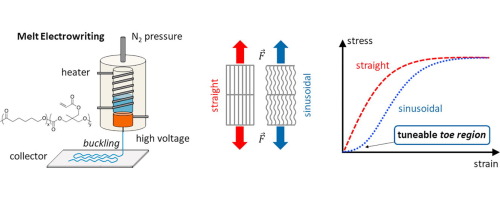Acta Biomaterialia ( IF 9.7 ) Pub Date : 2018-03-17 , DOI: 10.1016/j.actbio.2018.03.023 Gernot Hochleitner 1 , Fei Chen 2 , Carina Blum 1 , Paul D Dalton 1 , Brian Amsden 2 , Jürgen Groll 1

|
Ligaments and tendons are comprised of aligned, crimped collagen fibrils that provide tissue-specific mechanical properties with non-linear extension behaviour, exhibiting low stress at initial strain (toe region behaviour). To approximate this behaviour, we report fibrous scaffolds with sinusoidal patterns by melt electrowriting (MEW) below the critical translation speed (CTS) by exploitation of the natural flow behaviour of the polymer melt. More specifically, we synthesised photopolymerizable poly(L-lactide-co-ε-caprolactone-co-acryloyl carbonate) (p(LLA-co-ε-CL-co-AC)) and poly(ε-caprolactone-co-acryloyl carbonate) (p(ε-CL-co-AC)) by ring-opening polymerization (ROP). Single fibre (fØ = 26.8 ± 1.9 µm) tensile testing revealed a customisable toe region with Young’s Moduli ranging from E = 29 ± 17 MPa for the most crimped structures to E = 314 ± 157 MPa for straight fibres. This toe region extended to scaffolds containing multiple fibres, while the sinusoidal pattern could be influenced by printing speed. The synthesized polymers were cytocompatible and exhibited a tensile strength of σ = 26 ± 7 MPa after 104 cycles of preloading at 10 % strain while retaining the distinct toe region commonly observed in native ligaments and tendon tissue.
Statement of Significance
Damaged tendons and ligaments are serious and frequently occurring injuries worldwide. Recent therapies, including autologous grafts, still have severe disadvantages leading to a demand for synthetic alternatives. Materials envisioned to induce tendon and ligament regeneration should be degradable, cytocompatible and mimic the ultrastructural and mechanical properties of the native tissue. Specifically, we utilised photo-cross-linkable polymers for additive manufacturing (AM) with Melt Electrowriting (MEW). In this way, we were able to direct-write cytocompatible fibres of a few micrometres thickness into crimp-structured elastomer scaffolds that mimic the non-linear biomechanical behaviour of tendon and ligament tissue.
中文翻译:

通过 MEW 制备的卷曲弹性体支架具有模仿韧带和肌腱的非线性延伸行为
韧带和肌腱由对齐的、卷曲的胶原原纤维组成,它们提供具有非线性延伸行为的组织特异性机械性能,在初始应变时表现出低应力(脚趾区域行为)。为了近似这种行为,我们通过利用聚合物熔体的自然流动行为,通过低于临界平移速度 (CTS) 的熔体电写 (MEW) 报告了具有正弦图案的纤维支架。更具体地说,我们合成了可光聚合的聚(L-丙交酯-共-ε-己内酯-共-丙烯酰碳酸酯) (p(LLA-co-ε-CL-co-AC)) 和聚(ε-己内酯-共-丙烯酰碳酸酯) ) (p(ε-CL-co-AC)) 通过开环聚合 (ROP)。单纤维 (fØ = 26.8 ± 1.9 µm) 拉伸测试显示可定制的脚趾区域杨氏模量范围从 E = 29 ± 17 MPa(对于大多数卷曲结构)到 E = 314 ± 157 MPa(对于直纤维)。这个脚趾区域延伸到含有多根纤维的支架,而正弦图案可能会受到打印速度的影响。合成的聚合物具有细胞相容性,在 10 % 应变下预加载 10 4个循环后表现出 σ = 26 ± 7 MPa 的拉伸强度,同时保留了天然韧带和肌腱组织中常见的明显脚趾区域。
重要性声明
受损的肌腱和韧带是世界范围内严重且经常发生的伤害。最近的疗法,包括自体移植物,仍然具有严重的缺点,导致对合成替代品的需求。设想用于诱导肌腱和韧带再生的材料应该是可降解的、细胞相容的并模仿天然组织的超微结构和机械特性。具体来说,我们使用可光交联聚合物进行增材制造 (AM) 和熔融电写 (MEW)。通过这种方式,我们能够将几微米厚的细胞相容性纤维直接写入卷曲结构的弹性体支架中,模拟肌腱和韧带组织的非线性生物力学行为。



























 京公网安备 11010802027423号
京公网安备 11010802027423号